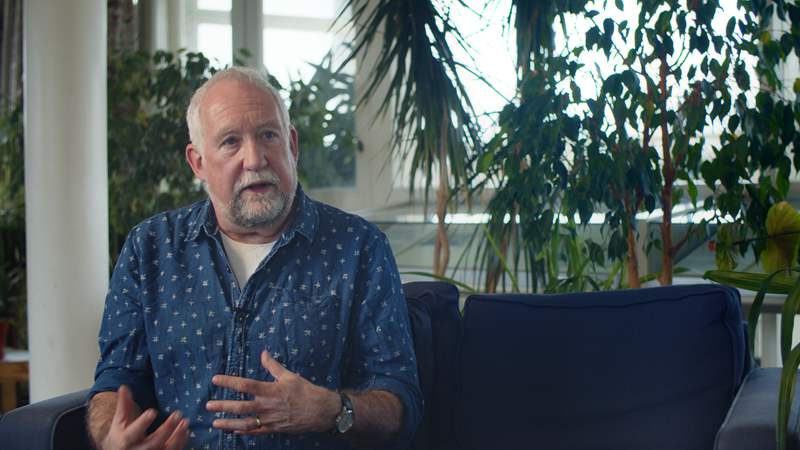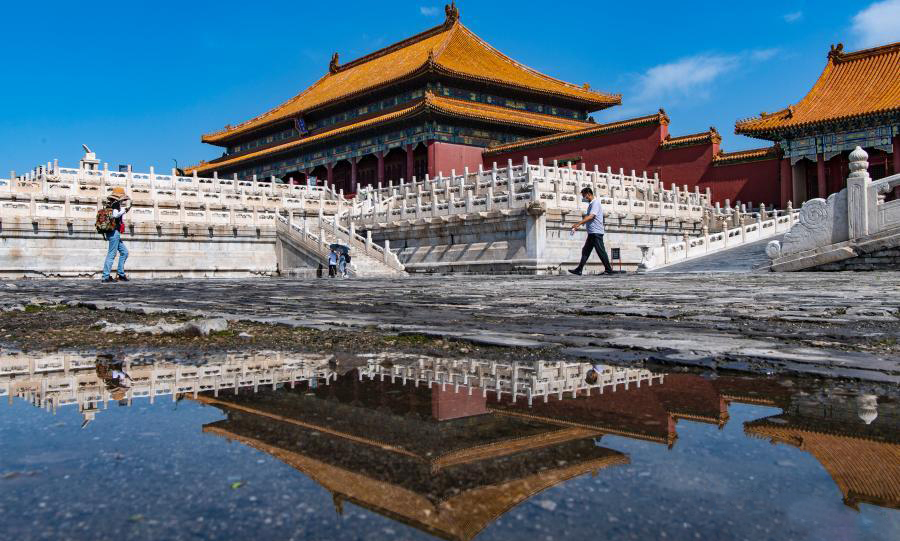Tim Williams: Rebooting cultural exchange along the Silk Road
Tim Williams is Professor of Silk Roads Archaeology at the Institute of Archaeology, University College London. Having obtained his first degree in 1980, he has over 40 years of experience in the field and has been teaching and training new generations of archaeologists and heritage management professionals for more than 20 years.
As the director of the Ancient Merv Project since 2001 and the author of multiple ICOMOS (International Council on Monuments and Sites) thematic studies along the Silk Roads, Williams has worked closely with China and other Asian countries for nearly two decades, culminating in the unprecedented transnational nomination of the World Heritage Site ‘Silk Roads: the Routes Network of Chang'an-Tianshan Corridor’ between China, Kazakhstan and Kyrgyzstan in 2014, and the establishment of the UCL-Northwest University International Centre for Silk Roads Archaeology & Heritage in 2018.
Currently, Williams is working with scholars from China and six other countries on the Central Asian Archaeological Landscape Project aimed at digitizing and sharing data on cultural heritage sites situated across Central Asia and western China.

Tim Williams (Photo/Fraser Watson)
Silk Roads: Connecting the East and West
People’s Daily Online: With over 40 years of experience in archaeology, your early projects were mostly in southern England. What was it that brought you all the way to the Silk Road of China?
Williams: I was lucky to start off with archaeology in urban archaeology in the UK. I was particularly interested in Roman towns and cities, from Colchester in late 1970s to heading to the Archaeology Commission of English Heritage in late 1990s. During that time, I worked on a rescue archaeology project in Beirut, Lebanon. I was fascinated by the transition of the city from a classical city into a medieval city, and this led me to study the Silk Road.
After joining the Institute of Archaeology in 2002, I started working in Central Asia. My research then focused primarily on the historic remains of Merv, the Great Silk Road city in Turkmenistan. And that in turn led me further down the Silk Road eastward to China where I first visited in 2005. That drew me into the glory and excitement of the quality of archaeology that existed within China, and the potential to carry out comparative research on the Silk Road.
People’s Daily Online: What are some of the most memorable moments in your first trip to China?
Williams: When I first got to China in 2005, we went on a mission to visit a whole range of sites. And what I was shocked by, to be honest, was the scale, quantity, and quality of the archaeology here. In a European context, I’ve never been interested in pre-history very much, there wasn’t enough data to play with.
Suddenly in China, you could go to sites from 5000 BC and see that scale and quality of archaeology. I went up to the site of Niuheliang in northeast China. The whole interconnectivity of this monumental burial architecture within the surrounding landscape, its positioning, and the quality of the survival of the material really brought home to me how exciting the pre-history research in China was. I then went to Xi’an for the first time and saw the remains of Chang’an, the ancient capital of China in the Han Dynasty (202 BC – 220 AD). Emperor Wudi (156 BC – 87 BC) sent envoys in the second century BC into Central Asia, fundamentally changing the scale of interaction between China and Central Asia.
In 2005, there was a sense that historians dealt with the historical period and archaeologists dealt with prehistory. It just seemed to me a phenomenal opportunity that archaeology has so much to offer to the study of the Silk Road. So, I thought that would be an interesting journey to work with Chinese colleagues on developing Silk Road studies in China.
People’s Daily Online: Having studied the northern section of the overland Silk Road since 2005, you recently started to look at the Maritime Silk Road. Could you share with us some of your discoveries there?
Williams: It’s a moot point as to how much we should divide the interconnection of maritime trade with the interconnection of overland trade. We have coastal forts, landmarks, and port cities. A lot of these are common issues that we have explored on the overland Silk Road. Ports represent a particularly complex heritage management challenge because good ports carry on being used and therefore, they tend to destroy the earlier harbor. Evidence of an earlier port in Shanghai was largely lost in the redevelopment of the city. And then we have shipwrecks, but the stuff that’s being shipped is made on land. So there’s a connectivity between what happens on the land and at sea. There is the phenomenal Nanhai No. 1 boat in the South China Sea, and it’s fascinating in terms of understanding how the trade is structured and organized.

Tim Williams (Photo/Fraser Watson)
Heritage sites: Integrating the community and landscape
People’s Daily Online: Archaeology isn’t only about carrying out excavations but also involves the preservation and presentation of sites afterwards. In your opinion, what has China achieved in the field of cultural heritage management?
Williams: From 2005 onwards, it was still a very top-down, state-driven approach, very much about ancient sites that belonged to the privileged. What has evolved over the last 15 to 20 years is a greater engagement with local communities, with how heritage sites fit within the landscape, and the way that heritage sites are used and developed, either as tourist resources or educational resources.
When I first went to China in 2005, very few Chinese universities taught anything to do with heritage management. Archaeology was very much about the study of archaeology. Now the top universities, such as Peking University and Northwest University, have really developed heritage management courses and have a lot of people teaching it. I think there is still a long way to go but there has been some really significant progress as well.
After the first successful World Heritage nomination in 2014 of the Chang’an-Tianshan Corridor, China recognised that they needed to bring the site managers of all those sites together to share their expertise. I was invited to participate in a number of workshops and meetings in China. It’s been an interesting process because my Chinese partners had important and exciting developments to bring to the meetings. So it’s not a simple issue of a UK university training Chinese students, it’s actually been a much more positive dialogue going both ways.
People’s Daily Online: While serving as the director of the International Centre for Silk Roads Archaeology and Heritage, which was jointly established by the UK’s University College London and China’s Northwest University in 2018, what were some of the projects you finished or are about to begin in collaboration with colleagues in China?
Williams: Northwest University has been a strong collaborator with us, and Professor Ma Jian, now head of the department, and Professor Wang Jianxin have been our strong supporters. It’s been a very productive relationship and so in 2019 we set up a joint Silk Road Centre for Archaeology and Heritage. More recently, NWU and Professor Ma have been our partners in the Central Asian Archaeological Landscape Project, a big five-year programme to help five Central Asian countries and the Xinjiang Uygur Autonomous Region of China to do the digital documentation of heritage, draw together digital inventories and digitise archives. I have a student from Urumqi and she is doing her PhD on the management of sites in the Taklamakan Desert. I would just love to be able to get out there and see those sites on the ground.

Tim Williams (Photo/Fraser Watson)
Transnational nominations: Promoting exchange and dialogue
People’s Daily Online: You mentioned your involvement in the nomination of UNESCO World Heritage Site ‘Silk Road: Chang’an-Tianshan,’ a project that has set the standard for future transnational nominations. What do you think is special about these kinds of transnational opportunities?
Williams: I think the collaboration between countries and things like the World Heritage nomination, particularly the idea of trans-boundary nominations, offer the opportunity for cultural dialogue and understanding. I joined the process for nominating the Silk Road in 2010 and nobody could work out how to nominate the Silk Road because theoretically it covered 26 countries, some of which were at war with each other. So how were you going to nominate a nominator? Initially, China was quite hopeful that it could nominate just the Silk Road sites within China but the consensus between all the countries was that they really wanted to keep this idea of transnationalism working. There had been no trans-boundary nomination for the overland Silk Road and the first one was the ‘Chang’an-Tianshan Corridor’ nominated by China, Kazakhstan, and Kyrgyzstan. World Heritage Sites have to report every five years. When China, Kazakhstan and Kyrgyzstan sent in three separate reports, they were sent back and UNESCO said: ‘No, you are one site. This is one World Heritage property.’ That was a watershed moment for realising it’s not just a one-off; and allowed the three countries to grow together. These transnational nominations have the opportunity to build that kind of soft power relationship between countries.
People’s Daily Online: As you said, the nomination of the ‘Chang’an-Tianshan Corridor’ set the foundation for further cultural exchange and capacity building between China, Kazakhstan and Kyrgyzstan. Now with the Belt and Road Initiative in motion, what is the role that collaborations like this would play in the future?
Williams: Partly through the Belt and Road Initiative, China is trying to develop archaeological research in areas like Central Asia. This has led to a number of opportunities for Central Asia to develop research and build up their capacity in heritage management, and that’s something that is hugely beneficial to the Central Asian countries who have very good archaeologists but lack the infrastructure, resources and laboratory-based skills that are available in China. Both Kazakhstan and Kyrgyzstan are very supportive of this process.
Currently, I’m working with ICOMOS that advises UNESCO, and we’re looking at extending the Silk Road thematic study to East Asia, covering not only the land routes through northeast China and the Korean Peninsula but also maritime exchanges across the Yellow Sea. The expert knowledge comes from Chinese, Korean and Japanese scholars, and it’s very useful to have people like myself who looks at the information from an outside perspective and draws out similarities, differences and issues in the process. Having said that, I don’t think it’s easy but I’m hoping that cultural diplomacy will actually have a benefit within that broad dialogue between the countries.
Photos
Related Stories
Copyright © 2022 People's Daily Online. All Rights Reserved.









